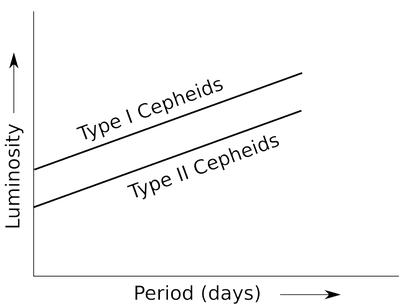
Understanding the use of Cepheid variables to determine distance is often glossed over in many astronomy books. The following is an attempt to address the use of Cepheid Variables in distance calculations.
By definition, a Cepheid Variable is a star that pulsates radially, varying in both diameter and temperature, thus producing changes in brightness with a well-defined stable period and amplitude. Or, in another way to describe it, Cepheid Variable stars are intrinsic variables which pulsate in a predictable way. In addition, how often a Cepheid star pulsates is directly related to its luminosity or brightness.
The discovery of the relationship between luminosity and period was made by Henrietta Swan Leavitt, during her tenure as one of the “Harvard Computers”. Beginning in 1893, Edward Charles Pickering, the Director of the Harvard College Observatory, hired a group of highly educated and skilled women to help him process astronomical data and data analysis using the large number of photographic plates that had been accumulated by the observatory. The “human computers” became known as the “Harvard Computers”. Joining Leavitt were Williamina Fleming, Annie Jump Cannon, Antonia Maury, and many more.
Two types of Cepheids are used for distance measurement. The Type I Cepheid variables is also known as the Classical Cepheid. Type I Cepheids are yellow bright giants and supergiants that undergo pulsations with very regular periods on the order of days to months.
Type II Cepheids variables are old, metal-poor stars that have periods of 1 to 50 days. The physical characteristics of all the type II Cepheid variables are very poorly known, but the longer period Type II Cepheids are more luminous and have proved useful in establishing distance.
Why does a Cepheid variable pulsate and vary in luminosity? A current thought is based on how the charge state of helium ions are produced in the fusion process within a Cepheid star. Cepheid variable stars are giant and supergiant stars 30 to 100 times or more the mass of the Sun. The process for the pulsation and varying luminosity is thought to be:
- Helium is formed at the core from the star’s fusion reactions.
- Due to the extreme size of the star, pressures and heat build up within the star.
- The heat and pressures causes He to lose an electron, turning He to He+. In this state, He+ is transparent.
- Heat continues to build, expanding the starand causing He+ to lose another electron, turning He+ to He++. He++ becomes opaque, thus dimming the star’s luminosity.
- The star’s expansion reach a point where the He++ cools, enabling the re-combination with electrons and returning the He++ to He+ and He atoms. As a result, the He becomes transparent again.
- The star shrinks to its starting point size.
- The process repeats with a period of 1 day to several months, depending on the size of the star.
- See step 1.
Cepheid variables are extremely luminous and very distant ones can be observed and measured because of this extreme luminosity. Once the period of a distant Cepheid has been measured, its luminosity can be determined from the known behavior of Cepheid variables. Then its absolute magnitude and apparent magnitude can be related by the distance modulation equation, Cepheid variables can be used to measure distances from about 1kilo-parsec to 50 mega-parsec.
The distance modulation equation is:
m –M = 5 log d– 5
where
m is the apparent magnitude of the object
M is the absolute magnitude of the object
d is the distance to the object in parsecs
The equation rearranged to determine distance results in:
d = 10(m – M + 5)/5 parsecs
If an astronomer observed a Cepheid star with period of 34 days, comparing to previously measured Cepheids, its absolute magnitude is -5.65. If its apparent magnitude was +23.0, the astronomer could use the distance modulus equation to find the distance to the Cepheid:
d = 10(23 – -5.65 + 5)/5 parsecs
d = 106.73 parsecs
where a parsec is equal to 3.26 light-years
d = 106.73 x 3.26 = 347.94 light-years
I hope this demystify’s the use of Cepheids for determining astronomical distances. Remember, the Cepheid variable technique is only one element of the astronomical distance ladder that I described in an earlier Jim’s Corner.